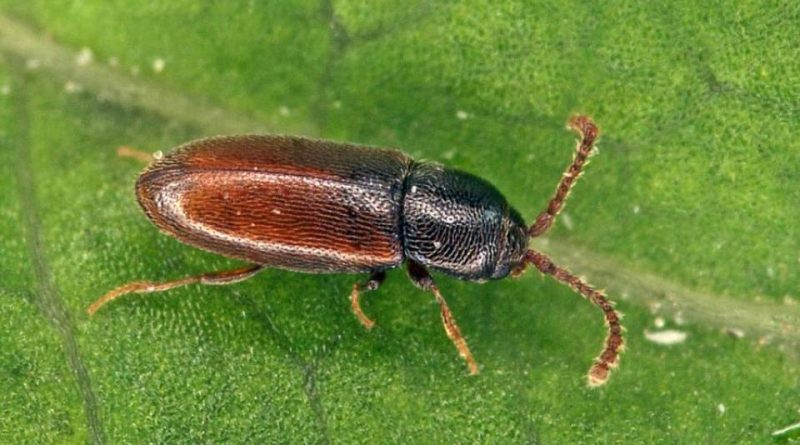Atomaria linearis
Atomaria linearis
Atomaria linearis (Atomaria linearis Stephens, 1830) is a small beetle belonging to the Cryptophagidae family.
Systematics –
From a systematic point of view, it belongs to the Eukaryota Domain, Animalia Kingdom, Subgenus Eumetazoa, Phylum Arthropoda, Subphylum Tracheata, Superclass Hexapoda, Class Insecta, Subclass Pterygota, Cohort Endopterygota, Superorder Oligoneoptera, Section Coleopteroidea, Order Coleoptera, Suborder Polyphaga, Superfamily Cucujoidea, Family Cryptophagidae and therefore the genus Atomaria and the species A. linearis.
Geographical Distribution and Habitat –
Atomaria linearis is a small beetle originating from Europe where it is widespread all over; the insect lives mainly on cultivations of beet and in favorable climatic conditions with temperatures between 10 and 20 ° C.
Morphology –
This beetle is recognized as the adults have a length of about 1.5 mm, with a brownish-brown color, slightly flattened with thin specks and tiny reddish bristles on the dorsal side; the antennas are reddish, with 11 articles and with the last three more enlarged than the others; the pronotum is with sides of equal size and with the lateral ones rounded especially in the front part; the elytrons are as wide as the prothorax; the legs have a yellowish color.
The eggs are 0.5 mm long, whitish, with a rounded shape and a smooth chorion.
The larvae measure about 2.5 mm, whitish, except for the head and the last segment which are slightly darker; the last abdominal segments have 2 curved hooks towards the inside and directed upwards; slightly velvety dorsal side.
Attitude and biological cycle –
Atomaria linearis is a beetle that can damage the chard in the early stages of development. In fact, the insect makes circular erosions at the collar level of the seedlings, about 1 mm below the ground level, the plants collapse being able to have, depending on the degree of presence of these insects, more or less extensive failures. The insect winters as an adult and turns 2-3 generations a year.
Mating takes place between the beginning of April and mid-June; the females lay, in an isolated way and in proximity of the collar of the plants, up to fifty eggs.
The larvae are born after 4-6 days and, having reached maturity in 35-40 days, pupate to give new adults after a couple of weeks.
The primary host is sugar beet but in the absence of the crop Atomaria linearis is able to colonize other genera such as wild Chenopodiacee (it has also been reported on some vegetables like spinach and radish). Occasionally it is able to live even on seeds in germination of legumes and grasses.
If the seasonal climatic trend is dry the erosions are located in the most buried section, up to about ten centimeters deep; with rainy trends and high environmental humidity erosions are located just below the collar or at ground level, sometimes also affecting the cotyledon leaves.
Moreover, on the transplanted seed beets, the adults who survived in the winter in the middle of the crown of leaves of the collar, perform small round erosions on the young foliar emissions.
As for the larvae, they live buried up to forty centimeters and feed at the expense of the root system of the host plants; exceptionally they can affect the epidermal layer of the main root. The greatest damage is to crops that have been broken down or subjected to shifts, as well as plots of land near land that hosted sugar beets or infested seed beet nurseries in the previous year.
Furthermore, sugar beets are frequently found, even in good numbers, in the middle of the leaflets of the heart damaged by the attacks of the Moth (Scrobipalpa ocellatella).
Ecological Role –
Atomaria linearis is especially suitable for cultivation located near lands where the strong presence of weeds (especially Chenopodium and Polygonum) in the previous year has favored the development of strong insect populations.
Its activity takes place with temperatures between 10 and 20 ° C with an optimum around 15.
The damage caused is relevant for the beet especially in the early stages of development as it performs circular erosions at the collar level of the seedlings.
The damage caused by the adult involves the seeds in germination, the hypocotyl, the cotyledon leaves and the young foliar emissions of the transplanted seed beets. On the beetroot they can attack the small buds thus preventing the emergence of the plants. More rarely, they perform erosions of the hypocotyl with a diameter of 0.5-2 mm. In correspondence of the erosions the necrotizing tissues with consequent appearance of bottlenecks that cause the withering and death of the plants. The containment of the infestations of this insect passes from good agronomic and agro-biological techniques. The agronomic interventions must be aimed at lowering the risk of infestation and, for this reason, the crop reflexes or the alternations too short are to be avoided.
Evidently, if a series of good changes in rotations, in consociations and in good agricultural practices to safeguard useful entomofauna and biodiversity of the ecosystem have not been adopted, the fight against Atomaria linearis will have to take place, together with other phytophagous plants of Bietola , by means of geodisinfestations performed at sowing.
Guido Bissanti
Sources
– Wikipedia, the free encyclopedia.- Russo G., 1976. Agrarian Entomology. Special Part. Liguori Editore, Naples.- Tremblay E., 1997. Applied entomology. Liguori Editore, Naples.

